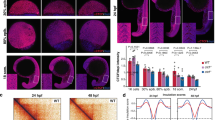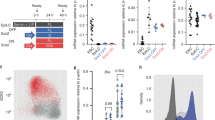Abstract
One of the earliest patterning events in the vertebrate neural plate is the specification of mes/r1, the territory comprising the prospective mesencephalon and the first hindbrain rhombomere. Within mes/r1, an interface of gene expression defines the midbrain–hindbrain boundary (MHB), a lineage restriction that separates the mesencephalon and rhombencephalon. wnt1 is critical to mes/r1 development and functions within the MHB as a component of the MHB gene regulatory network (GRN). Despite its importance to these critical and early steps of vertebrate neurogenesis, little is known about the factors responsible for wnt1 transcriptional regulation. In the zebrafish, wnt1 and its neighboring paralog, wnt10b, are expressed in largely overlapping patterns, suggesting co-regulation. To understand wnt1 and wnt10b transcriptional control, we used a comparative genomics approach to identify relevant enhancers. We show that the wnt1-wnt10b locus contains multiple cis-regulatory elements that likely interact to generate the wnt1 and wnt10b expression patterns. Two of 11 conserved enhancers tested show activity restricted to the midbrain and MHB, an activity that is conserved in the distantly related spotted gar orthologous elements. Three non-conserved elements also play a likely role in wnt1 regulation. The identified enhancers display dynamic modes of chromatin accessibility, suggesting controlled deployment during embryogenesis. Our results suggest that the control of wnt1 and wnt10b expression is under complex regulation involving the interaction of multiple enhancers.







Similar content being viewed by others
References
Andersson ER, Salto C, Villaescusa JC, Cajanek L, Yang S, Bryjova L, Nagy II, Vainio SJ, Ramirez C, Bryja V, Arenas E (2013) Wnt5a cooperates with canonical Wnts to generate midbrain dopaminergic neurons in vivo and in stem cells. Proc Natl Acad Sci U S A 110:E602–E610
Ang K, Sanchez Rangel E, Yuan Q, Wu D, Carpenter TO, Insogna K (2018) Skeletal disease in a father and daughter with a novel monoallelic WNT1 mutation. Bone Rep 9:154–158
Braasch I, Postlethwait JH (2017) The spotted gar: genomic journeys into a lost world. J Exp Zool B Mol Dev Evol 328:593–595
Buckles GR, Thorpe CJ, Ramel MC, Lekven AC (2004) Combinatorial Wnt control of zebrafish midbrain-hindbrain boundary formation. Mech Dev 121:437–447
Bulger M, Groudine M (2011) Functional and mechanistic diversity of distal transcription enhancers. Cell 144:327–339
Calo E, Wysocka J (2013) Modification of enhancer chromatin: what, how, and why? Mol Cell 49:825–837
Chen H, Levo M, Barinov L, Fujioka M, Jaynes JB, Gregor T (2018) Dynamic interplay between enhancer-promoter topology and gene activity. Nat Genet 50:1296–1303
Danielian PS, Echelard Y, Vassileva G, McMahon AP (1997) A 5.5-kb enhancer is both necessary and sufficient for regulation of wnt-1 transcription in vivo. Dev Biol 192:300–309
Dickel DE, Ypsilanti AR, Pla R, Zhu Y, Barozzi I, Mannion BJ, Khin YS, Fukuda-Yuzawa Y, Plajzer-Frick I, Pickle CS, Lee EA, Harrington AN, Pham QT, Garvin TH, Kato M, Osterwalder M, Akiyama JA, Afzal V, Rubenstein JLR, Pennacchio LA, Visel A (2018) Ultraconserved enhancers are required for normal development. Cell 172:491–499 e415
Dorsky RI, Moon RT, Raible DW (1998) Control of neural crest cell fate by the Wnt signalling pathway. Nature 396:370–373
Echelard Y, Vassileva G, McMahon AP (1994) Cis-acting regulatory sequences governing wnt-1 expression in the developing mouse CNS. Development 120:2213–2224
Fahiminiya S, Majewski J, Mort J, Moffatt P, Glorieux FH, Rauch F (2013) Mutations in WNT1 are a cause of osteogenesis imperfecta. J Med Genet 50:345–348
Falk S, Wurdak H, Ittner LM, Ille F, Sumara G, Schmid MT, Draganova K, Lang KS, Paratore C, Leveen P, Suter U, Karlsson S, Born W, Ricci R, Gotz M, Sommer L (2008) Brain area-specific effect of TGF-beta signaling on Wnt-dependent neural stem cell expansion. Cell Stem Cell 2:472–483
Fukaya T, Lim B, Levine M (2016) Enhancer control of transcriptional bursting. Cell 166:358–368
Gellner K, Brenner S (1999) Analysis of 148 kb of genomic DNA around the wnt1 locus of Fugu rubripes. Genome Res 9:251–258
Gibbs HC, Dodson CR, Bai Y, Lekven AC, Yeh AT (2014) Combined lineage mapping and gene expression profiling of embryonic brain patterning using ultrashort pulse microscopy and image registration. J Biomed Opt 19:126016
Gibbs HC, Chang-Gonzalez A, Hwang W, Yeh AT, Lekven AC (2017) Midbrain-hindbrain boundary morphogenesis: at the intersection of Wnt and Fgf signaling. Front Neuroanat 11:64
Green D, Whitener AE, Mohanty S, Lekven AC (2015) Vertebrate nervous system posteriorization: grading the function of Wnt signaling. Dev Dyn 244:507–512
Harmston N, Ing-Simmons E, Tan G, Perry M, Merkenschlager M, Lenhard B (2017) Topologically associating domains are ancient features that coincide with metazoan clusters of extreme noncoding conservation. Nat Commun 8:441
Hidalgo-Sanchez M, Simeone A, Alvarado-Mallart RM (1999) Fgf8 and Gbx2 induction concomitant with Otx2 repression is correlated with midbrain-hindbrain fate of caudal prosencephalon. Development 126:3191–3203
Ikeya M, Lee SM, Johnson JE, McMahon AP, Takada S (1997) Wnt signalling required for expansion of neural crest and CNS progenitors. Nature 389:966–970
Itoh M, Kudoh T, Dedekian M, Kim CH, Chitnis AB (2002) A role for iro1 and iro7 in the establishment of an anteroposterior compartment of the ectoderm adjacent to the midbrain-hindbrain boundary. Development 129:2317–2327
Katoh Y, Katoh M (2005) Identification and characterization of rat wnt1 and wnt10b genes in silico. Int J Oncol 26:841–845
Kemp C, Willems E, Abdo S, Lambiv L, Leyns L (2005) Expression of all Wnt genes and their secreted antagonists during mouse blastocyst and postimplantation development. Dev Dyn 233:1064–1075
Keupp K, Beleggia F, Kayserili H, Barnes AM, Steiner M, Semler O, Fischer B, Yigit G, Janda CY, Becker J, Breer S, Altunoglu U, Grunhagen J, Krawitz P, Hecht J, Schinke T, Makareeva E, Lausch E, Cankaya T, Caparros-Martin JA, Lapunzina P, Temtamy S, Aglan M, Zabel B, Eysel P, Koerber F, Leikin S, Garcia KC, Netzer C, Schonau E, Ruiz-Perez VL, Mundlos S, Amling M, Kornak U, Marini J, Wollnik B (2013) Mutations in wnt1 cause different forms of bone fragility. Am J Hum Genet 92:565–574
Lagutin OV, Zhu CC, Kobayashi D, Topczewski J, Shimamura K, Puelles L, Russell HR, McKinnon PJ, Solnica-Krezel L, Oliver G (2003) Six3 repression of Wnt signaling in the anterior neuroectoderm is essential for vertebrate forebrain development. Genes Dev 17:368–379
Laine CM, Joeng KS, Campeau PM, Kiviranta R, Tarkkonen K, Grover M, Lu JT, Pekkinen M, Wessman M, Heino TJ, Nieminen-Pihala V, Aronen M, Laine T, Kroger H, Cole WG, Lehesjoki AE, Nevarez L, Krakow D, Curry CJ, Cohn DH, Gibbs RA, Lee BH, Makitie O (2013) wnt1 mutations in early-onset osteoporosis and osteogenesis imperfecta. N Engl J Med 368:1809–1816
Lekven AC, Buckles GR, Kostakis N, Moon RT (2003) wnt1 and wnt10b function redundantly at the zebrafish midbrain-hindbrain boundary. Dev Biol 254:172–187
Makitie RE, Niinimaki T, Nieminen MT, Schalin-Jantti C, Niinimaki J, Makitie O (2017) Impaired Wnt signaling and the spine-heterozygous wnt1 mutation causes severe age-related spinal pathology. Bone 101:3–9
McMahon AP, Bradley A (1990) The wnt-1 (int-1) proto-oncogene is required for development of a large region of the mouse brain. Cell 62:1073–1085
McMahon AP, Joyner AL, Bradley A, McMahon JA (1992) The midbrain-hindbrain phenotype of wnt-1-/wnt-1- mice results from stepwise deletion of engrailed-expressing cells by 9.5 days postcoitum. Cell 69:581–595
Millet S, Campbell K, Epstein DJ, Losos K, Harris E, Joyner AL (1999) A role for Gbx2 in repression of Otx2 and positioning the mid/hindbrain organizer. Nature 401:161–164
Narayanan A, Lekven AC (2012) Biphasic wnt8a expression is achieved through interactions of multiple regulatory inputs. Dev Dyn 241:1062–1075
Nusse R (2001) An ancient cluster of Wnt paralogues. Trends Genet 17:443
Osterwalder M, Barozzi I, Tissieres V, Fukuda-Yuzawa Y, Mannion BJ, Afzal SY, Lee EA, Zhu Y, Plajzer-Frick I, Pickle CS, Kato M, Garvin TH, Pham QT, Harrington AN, Akiyama JA, Afzal V, Lopez-Rios J, Dickel DE, Visel A, Pennacchio LA (2018) Enhancer redundancy provides phenotypic robustness in mammalian development. Nature 554:239–243
Pyott SM, Tran TT, Leistritz DF, Pepin MG, Mendelsohn NJ, Temme RT, Fernandez BA, Elsayed SM, Elsobky E, Verma I, Nair S, Turner EH, Smith JD, Jarvik GP, Byers PH (2013) WNT1 mutations in families affected by moderately severe and progressive recessive osteogenesis imperfecta. Am J Hum Genet 92:590–597
Qi HH, Sarkissian M, Hu GQ, Wang Z, Bhattacharjee A, Gordon DB, Gonzales M, Lan F, Ongusaha PP, Huarte M, Yaghi NK, Lim H, Garcia BA, Brizuela L, Zhao K, Roberts TM, Shi Y (2010) Histone H4K20/H3K9 demethylase PHF8 regulates zebrafish brain and craniofacial development. Nature 466:503–507
Qurrat Ul A, Seemab U, Nawaz S, Rashid S (2011) Integrative analyses of conserved WNT clusters and their co-operative behaviour in human breast cancer. Bioinformation 7:339–346
Raible F, Brand M (2004) Divide et impera—the midbrain-hindbrain boundary and its organizer. Trends Neurosci 27:727–734
Ramel MC, Buckles GR, Lekven AC (2004) Conservation of structure and functional divergence of duplicated wnt8s in pufferfish. Dev Dyn 231:441–448
Remeseiro S, Hornblad A, Spitz F (2016) Gene regulation during development in the light of topologically associating domains. Wiley Interdiscip Rev Dev Biol 5:169–185
Rhinn M, Lun K, Amores A, Yan YL, Postlethwait JH, Brand M (2003) Cloning, expression and relationship of zebrafish gbx1 and gbx2 genes to Fgf signaling. Mech Dev 120:919–936
Rowitch DH, Echelard Y, Danielian PS, Gellner K, Brenner S, McMahon AP (1998) Identification of an evolutionarily conserved 110 base-pair cis-acting regulatory sequence that governs wnt-1 expression in the murine neural plate. Development 125:2735–2746
Sylvester JB, Rich CA, Loh YH, van Staaden MJ, Fraser GJ, Streelman JT (2010) Brain diversity evolves via differences in patterning. Proc Natl Acad Sci U S A 107:9718–9723
Tallafuss A, Wilm TP, Crozatier M, Pfeffer P, Wassef M, Bally-Cuif L (2001) The zebrafish buttonhead-like factor Bts1 is an early regulator of pax2.1 expression during mid-hindbrain development. Development 128:4021–4034
Thomas KR, Capecchi MR (1990) Targeted disruption of the murine int-1 proto-oncogene resulting in severe abnormalities in midbrain and cerebellar development. Nature 346:847–850
Urasaki A, Morvan G, Kawakami K (2006) Functional dissection of the Tol2 transposable element identified the minimal cis-sequence and a highly repetitive sequence in the subterminal region essential for transposition. Genetics 174:639–649
Wassarman KM, Lewandoski M, Campbell K, Joyner AL, Rubenstein JL, Martinez S, Martin GR (1997) Specification of the anterior hindbrain and establishment of a normal mid/hindbrain organizer is dependent on Gbx2 gene function. Development 124:2923–2934
Westerfield M (2000) The zebrafish book. A guide for the laboratory use of zebrafish (Danio rerio), 4th edn. University of Oregon Press, Eugene
Wilkinson DG, Bailes JA, McMahon AP (1987) Expression of the proto-oncogene int-1 is restricted to specific neural cells in the developing mouse embryo. Cell 50:79–88
Wurst W, Bally-Cuif L (2001) Neural plate patterning: upstream and downstream of the isthmic organizer. Nat Rev Neurosci 2:99–108
Yu M, Ren B (2017) The three-dimensional organization of mammalian genomes. Annu Rev Cell Dev Biol 33:265–289
Zervas M, Millet S, Ahn S, Joyner AL (2004) Cell behaviors and genetic lineages of the mesencephalon and rhombomere 1. Neuron 43:345–357
Zervas M, Blaess S, Joyner AL (2005) Classical embryological studies and modern genetic analysis of midbrain and cerebellum development. Curr Top Dev Biol 69:101–138
Zhang B, Tran U, Wessely O (2011) Expression of Wnt signaling components during Xenopus pronephros development. PLoS One 6:e26533
Acknowledgements
The authors thank Dr. Jo-Ann Fleming for thoughtful discussions regarding this work and for fish care and Dr. Laura Beaster-Jones for discussions and assistance during various stages of this project. We are also grateful to Dr. Ingo Braasch and Dr. John Postlethwait for kindly providing spotted gar samples.
Funding
This work was supported in part by NIH grant 1R01NS088564.
Author information
Authors and Affiliations
Corresponding author
Additional information
Communicated by Caroline Brennan
Publisher’s note
Springer Nature remains neutral with regard to jurisdictional claims in published maps and institutional affiliations.
Rights and permissions
About this article
Cite this article
Lekven, A.C., Lilie, C.J., Gibbs, H.C. et al. Analysis of the wnt1 regulatory chromosomal landscape. Dev Genes Evol 229, 43–52 (2019). https://doi.org/10.1007/s00427-019-00629-5
Received:
Accepted:
Published:
Issue Date:
DOI: https://doi.org/10.1007/s00427-019-00629-5




